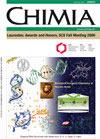纳米孔技术:当蛋白质分析蛋白质。
IF 1.6
4区 化学
Q3 CHEMISTRY, MULTIDISCIPLINARY
引用次数: 0
摘要
纳米孔传感是一种新兴的技术,可以区分分子的细微差异,并允许观察分子过程。这项技术通过长时间读取单个分子,彻底改变了DNA测序。在这一成功之后,纳米孔现在越来越多地应用于蛋白质分析。蛋白质在细胞功能和重大疾病中发挥着核心作用,然而,由于缺乏蛋白质扩增方法,使用现有方法对蛋白质进行分析变得复杂。本文介绍了基于纳米孔的蛋白质分析的两个例子:生物标志物的鉴定和蛋白质功能的分析。本文章由计算机程序翻译,如有差异,请以英文原文为准。
Nanopore Technology: When Proteins Analyse Proteins.
Nanopore sensing is an emerging technology that can distinguish subtle differences in molecules and allows the observation of molecular processes. The technique has revolutionized DNA sequencing through long reads of single molecules. Following this success, nanopores are now increasingly applied to protein analysis. Proteins play central roles in cellular function and major diseases, however their analysis using established methods is complicated by the lack of protein-amplification methods. Here, two examples of nanopore-based protein analysis are described: the identification of biomarkers, and the analysis of protein function.
求助全文
通过发布文献求助,成功后即可免费获取论文全文。
去求助
来源期刊

Chimia
化学-化学综合
CiteScore
1.60
自引率
0.00%
发文量
144
审稿时长
2 months
期刊介绍:
CHIMIA, a scientific journal for chemistry in the broadest sense covers the interests of a wide and diverse readership. Contributions from all fields of chemistry and related areas are considered for publication in the form of Review Articles and Notes. A characteristic feature of CHIMIA are the thematic issues, each devoted to an area of great current significance.
 求助内容:
求助内容: 应助结果提醒方式:
应助结果提醒方式:


